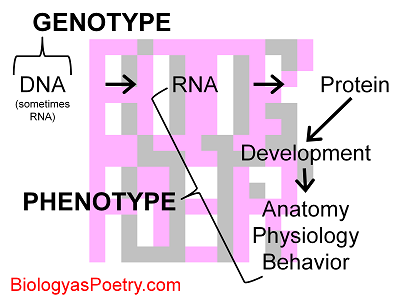∞ generated and posted on 2016.08.21 ∞
The 'stuff' that you can see and measure about an organism.
The contrast with phenotype is what you can "read" about an organism or, more precisely, what you can sequence. Phenotype, however, can be inferred from sequence, in particular the DNA making up an organism's genome. Phenotype thus represents every aspect of an organism except for its genotype.
Phenotype is related to genotype through gene expression. The mapping of phenotype onto genotype, however, is imperfect due to the influence of environment on phenotype along with other complications to predicting phenotype from genotype data alone, such as epistasis. The existence of a given gene in an organism's genome – more precisely, a given allele – does not, in other words, guarantee a specific phenotype and this is due to various complications in converting genotype information into phenotype.
Phenotypes can be differentiated in terms of traits, characters, and adaptations. Phenotype more specifically can be observed as anatomical, morphological, physiological, and behavioral characteristics. Phenotype also can continue beyond the body, presenting what can be described as an extended phenotype.

Figure legend: Comparing the concepts of genotype and phenotype. Genotype basically is genome nucleic acid sequence, usually DNA but in the case of RNA viruses, RNA instead. Genotype primarily is transcribed to generate phenotype, that is, RNA is produced based upon DNA sequence. Though to a limited extent phenotype generation need not proceed beyond RNA, in most instances protein is then generated from RNA sequence via the process of translation. Phenotype then matures or develops in various aspects, giving rise to how an organisms looks (its anatomy), how it works (its physiology), and how it acts (its behavior).
Phenotype is everything we can describe about an organism except for the nucleic acid-encoded information that is passed from parent to offspring. Phenotype is what genotype interacts with the environment through. Phenotype is what natural selection interacts with in distinguishing among genotypes. Phenotype is everything that you are aware of about yourself except in terms of how you share traits with relatives (or if you should have your genome sequenced or otherwise undergo genetic testing).
Phenotype thus is the means by which your genes interact with your environment and the production of genotype typically involves the production of protein molecules as templated by DNA. The actual process of phenotype generation typically involves the copying of DNA-based information into RNA-based information via a process known as transcription. RNA-based information is then copied into amino acid-based information, that is, polypeptides and proteins, via the process known as translation. Proteins can either form the direct basis of phenotype as structural molecules or, as enzymes, can catalyze the formation of yet additional molecules which directly serve as what in fact you can see and measure about an organism.
During much of the development of the science of genetics, genotype was at best only inferable from phenotype information. All that has changed, however, with advent of nucleic acid sequencing which allows a direct observation of genotype information. Paradoxically, DNA sequencing has become so facile that it has become far easier not only to determine genotype directly by sequencing the DNA of extant organisms, contrasting as inferred from phenotype, but indeed genotype can be easier to determine in many instances than phenotype itself.